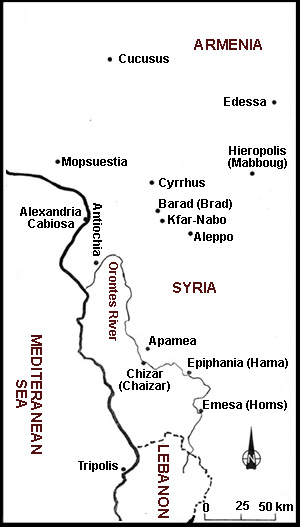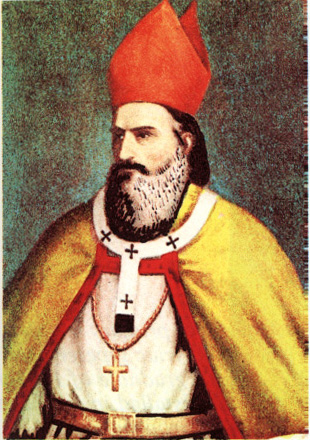"Ornament of the Divine Choir of Saints" By Guita G. Hourani
In this section of the Journal of Maronite Studies (JMS), we share with you documents and manuscripts that reflect the history of the Maronite people and church. Whenever possible, we will feature a copy of the original record with an English translation. Should we not be able to do so, we shall rely on the integrity of the author(s) who first brought this record to our attention. The Editor's interpolations will appear in square brackets. It is well known that in the 4th A.D. century, monasticism flourished
in Saint Anthony's Egypt and in the Palestine of Saint Hilarion. It is
perhaps less well known that the ascetic way of life also was thriving
in Syria, Antioch, and Mesopotamia at this time. One of the leaders of
such ascetic life was hermit named Maron.
The earliest written information about Saint Maron (d.410) (1) can be found in Historia Religiosa (c. 440) of Theodoret, Bishop of Cyrrhus (393-466) and in a letter of John Chrysostom, Patriarch of Constantinople (344-407), both written in Greek (2). Theodoret was a revered writer of his time. His book, the Historia Religiosa, is a preeminent source for early Syrian monastic and ascetic life. [Although he was a contemporary of Saint Maron, there is no direct evidence that indicates that the two had met.] In his book, Theodoret wrote: "After him [Acepsimas] I shall recall Maron, for he too adorned the godly choir of the saints. Embracing the open-air life, he repaired to a hill-top formerly honored by the impious. Consecrating to God the precinct of demons on it, he lived there, pitching a small tent which he seldom used. He practiced not only the usual labors, but devised others as well, heaping up the wealth of philosophy. The Umpire measured out grace according to his labors: so the magnificent one gave in abundance the gift of healing, with the result that his fame circulated everywhere, attracted everyone from every side and taught by experience the truth of the report. One could see fevers quenched by the dew of his blessing, shivering quieted, demons put to flight, and varied diseases of every kind cured by a single remedy; the progeny of physicians apply to each disease the appropriate remedy, but the prayer of the saint is a common antidote for every distress. He cured not only infirmities of the body, but applied suitable treatment to souls as well, healing this man's greed and that man's anger, to this man supplying teaching in self-control and to that providing lessons in justice, correcting this man's intemperance and shaking up another man's sloth. Applying this mode of cultivation, he produced many plants of philosophy, and it was he who planted for God the garden that now flourishes in the region of Cyrrhus (3). A product of his planting was the great James, to whom one could reasonably apply the prophetic utterance, 'the righteous man will flower as the palm tree, and be multiplied like the cedar of Lebanon' (4), and also all the others whom, with God's help, I shall recall individually. Attending in this way to the divine cultivation and treating souls and bodies alike, he himself underwent a short illness, so that we might learn the weakness of nature and the manliness of resolution, and departed from life. A bitter war over his body arose between his neighbors. One of the adjacent villages that was well-populated came out in mass, drove off the others and seized this thrice desired treasure ['Saint Maron wished to be buried with the hermit Zebinas'] (5) building a great shrine, they reap benefit therefrom even to this day, honoring this victor with a public festival. We ourselves reap his blessing even at a distance; for sufficient for us instead of his tomb is his memory" (6). The other major source of information about Saint Maron comes from Saint John Chrysostom that is "John the Golden Mouth." He became Patriarch of Constantinople in 397. He dedicated his 36th epistle to Saint Maron while exiled in Cucussus (7), Armenia, around the year 405. The 36th epistle reads as follows: "To Maron, the Monk Priest: We are bound to you by love and interior disposition, and see you here before us as if you were actually present. For such are the eyes of love; their vision is neither interrupted by distance nor dimmed by time. We wished to write more frequently to your reverence, but since this is not easy on account of the difficulty of the road and the problems to which travellers are subject, whenever opportunity allows we address ourselves to your honour and assure you that we hold you constantly in our mind and carry you about in our soul wherever we may be. And take care yourself that you write to us as often as you can, telling us how you are, so that although separated physically we might be cheered by learning constantly about your health and receive much consolation as we sit in solitude. For it brings us no small joy to hear about your health. And above all please pray for us". (8) After Saint Maron's death, his relics were the object of considerable
interest and conflict. The people of a neighboring village, believed to
be Brad or Barad in the environs of Kfar-Nabo (9), succeeded
in taking his body (10).
Then a church was built in his name, and a sarcophagus containing the Saint's body was housed in it. It is believed that later the Saint's skull was transported by the Saint's disciples to Apamea (11) in Syria where they built the famous Saint Maron Monastery or "Beit Maron" around the year 452 (12). According to the Arab historian Al-Mas'oudi (d.960): "there was dedicated to him (St. Maron) a great convent, located in the east of Hamah and Chizar. It was a splendid building. Around it were three hundred cells, inhabited by monks.... That convent was sacked, and the cells around it, by the many raids of the Arabs and by the cruelty of the Sultan. It is situated on the shore of the Orontes, the river of Emese and Antioch." (13) Patriarch Istephan Duwayhi in his book T'arikh al-Azmina tells us that when Patriarch Youhanna (John) Maron, the first Maronite Patriarch, settled in Kfarhay, in the Batroun region of Lebanon at the beginning of the 8th century: "he built an altar and a monastery after Saint Maron's name and put Saint Maron's skull inside the altar to heal the faithful. This is why the Monastery is called "Rish Mro" Syriac for Maron's head (14).
Luigi Jacobilli in his book Vite De' Santi e Beati Dell'Umbria (15) asserts that in the year 1130 A.D., Saint Maron's skull was again moved-- this time to Foligno, Italy. The Bibliotheca Sanctorum (16) records the following: In regard to the relics of St. Maron, Jacobilli affirms that the Saint's skull is now preserved in Foligno after being transferred three times. The first transfer was in 1130, when Abbot Michel of the Croce di Sassovivo while on a pilgrimage to the Holy land, brought back the skull of the honored Saint from a Maronite monastery in Syria. A short while after, and at the request of the same Abbot, the skull was moved from Sassovivo to a church erected in honor of the Saint in a nearby town of Volperino. The third transfer was in 1490 when the relic of the Saint was moved from Volperino to the Cathedral of Foligno where it was placed in a silver statue. The authenticity of the first transfer [from Syria to Sassovivo] is recorded in the Chronicon Monasterii S. Crucis Saxivivi, the other two transfers are noted in the archive of the Church in Volperino and the Town Hall of Foligno. [Editor's translation] (17) Chorbishop Youssef Debs in his book Histoire de Syrie asserts that he was given a relic of the honored Saint by the Bishop of Foligno during his visit to Italy in 1887. (18) Saint Maron left a legacy behind him that flourishes today in a people named after him-- the Maronites. The Maronites, now are virtually found in almost every country of the world. Saint Maron's feast day is celebrated on February 9 of every year in all the Maronite churches around the world. This day is also an official national day in the State of Lebanon. (1) Also written as follows: Maro, Maroun, Marun, Maroon. | Back to text | (2) |The text of Theodoret is published in "Patrologiae Graecae", vol. LXXXII, 1864, column 1417 and 1419 and that of John Chrysostom in "Patrologiae Graecae", vol. 51.3, 1862, the 36 epistle, column 630. | Back to text | (3) Cyrrhus, Cyr, Quros, or Hagioupolis, is now Huru Pegamber in Eastern Turkey. The Oxford Dictionary of Byzantium, vol. I, (Oxford, 1991), pp. 574-575. | Back to text | (4) Psalm 92:12. | Back to text | (5) Theodore of Cyrrhus. A History of the Monks of Syria. Translated by R. M. Price, (Michigan, 1985), p. 119, note # 3. | Back to text | (6) Ibid., pp. 117-119. | Back to text | (7) Cucusa, or Cucusus is now in Turkey. | Back to text | (8) AbouZayd, S. Ihidayutha: A study of the Life of Singleness in the Syrian Orient: From Ignatius of Antioch to Chalcedon 451 A.D., (Oxford, 1993), p. 363. | Back to text | (9) Dau, B. Histoire des Maronites (in Arabic), (Beirut, 1890), pp. 30-31, and Ihidayutha, p. 364. | Back to text | (10) Competition to obtain the bodies of holy men is well known in the Orient. For more information, please consult the History of the Monks of Syria, pp. 92, 119, 123-124, and 136. | Back to text | (11) Apamea Cherronesus, or Qala'at el-Mudig is between Hamah and Aleppo in today's Syria. Atlas of the Early Christian World. Translated and Edited by Hedlund, M. And Rowley, H., (Amesterdam, 1959). | Back to text | (12) Khoury-Harb, A. The Maronites, (Beirut, 1985), pp. 38-40. | Back to text | (13) Al-Mas'oudi, Le livre de l'avertissement et de la revision,. Translation Cara de Vaux, 1897, p. 211. Translation is the Editor's. | Back to text | (14) Khoury-Harb, A.The Maronites, p. 40. | Back to text | (15) Jacobilli, Luigi. Vite de' Santi e Beati dell'Umbria, l. II, (Foligno, 1656), pp. 134-138. | Back to text | (16) "Bibliotheca Sanctorum, Instituto Giovanni XXXIII Della Pontificia Universita Lateranense", (Roma, 1967), columns 1195 and 1196. | Back to text | (17) Ibid., column 1195 and 1196. Translation is the Editor's. | Back to text | (18) Khoury-Harb, A. The Maronites, p. 40. | Back to text | |


